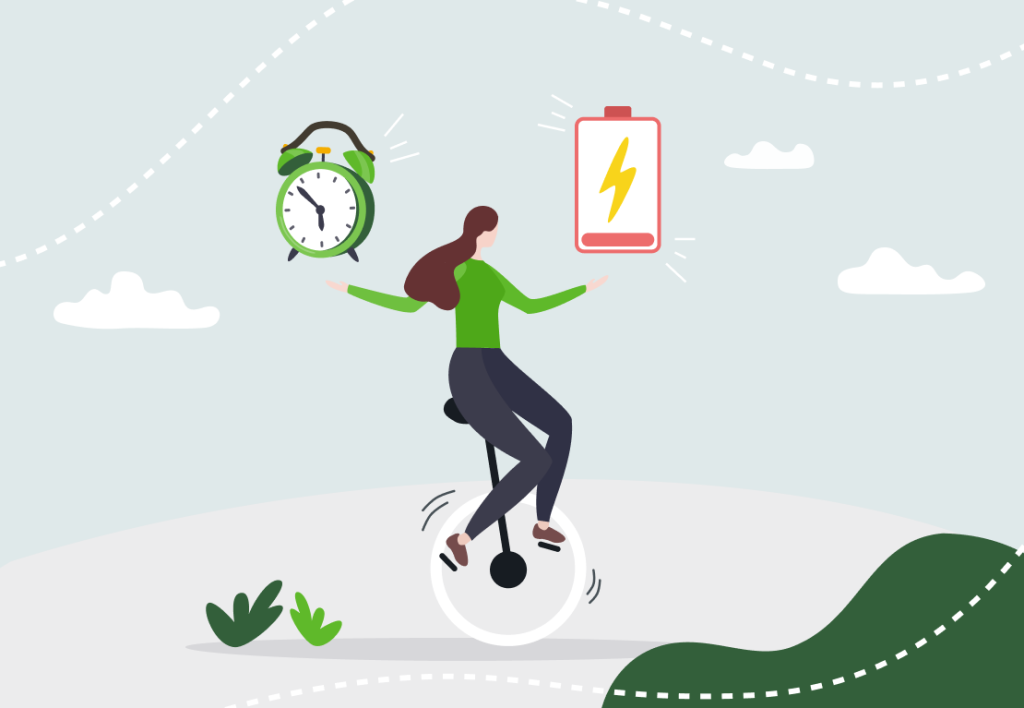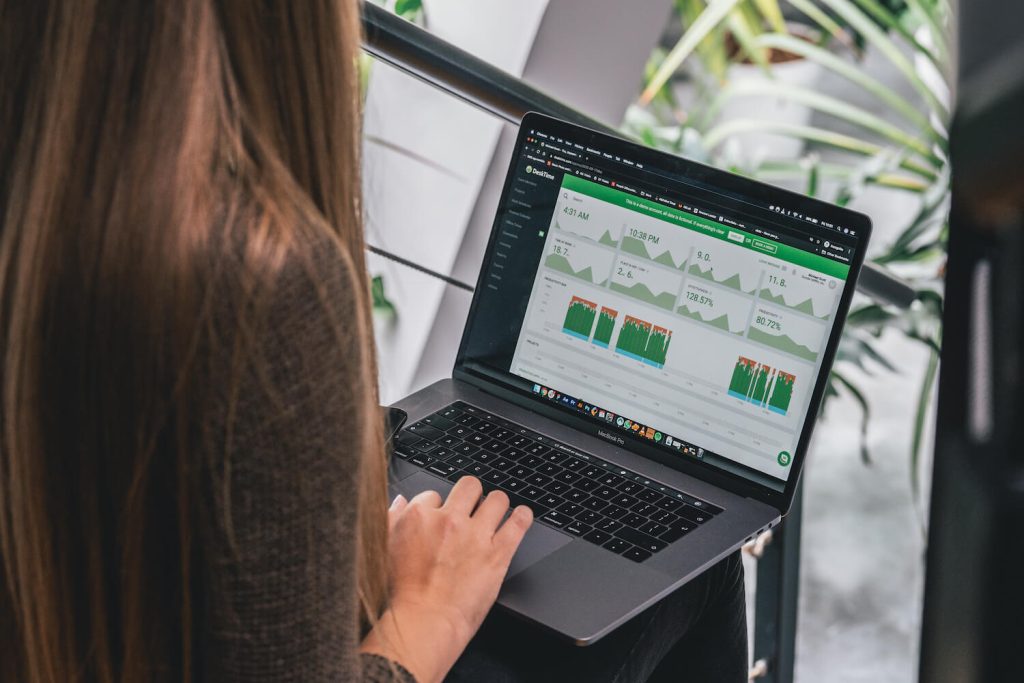Managing time vs. energy – can both work together to boost productivity?

Time management is one of the most popular strategies used to increase productivity in the workplace. It’s about optimizing your workload in a way that you can achieve more in less time.
Planning out your work day to the minute sounds good, but you won’t get far without having the mental or physical energy to actually complete the tasks on your to-do list. That’s where energy management comes in.
Want to get the most out of your time?
Try DeskTime for free!
Try free for 14 days · No credit card required.
By signing up, you agree to our terms and privacy policy.

Manage your energy, not your time
It may seem that time management and energy management are two completely different productivity strategies, but the two can be used to benefit each other. Time management is all about controlling the time spent on different tasks, and its primary goal is to carry out as much work as possible in less time.
While there are many great time management tips out there, most of them focus on task completion rather than the person who is completing them. Time is a finite resource, whereas energy is something that needs to be consistently recharged. Thus, in order to succeed in time management, an effective strategy may be to focus on managing your energy, not your time.
How to use energy management as a productivity strategy?
If you want to manage your time at work by managing your energy, consider these five ways to be more productive:
1. Track your energy levels throughout the day

Some managers expect their employees to be highly productive at all times, but that’s simply an unrealistic ask. Our energy levels fluctuate throughout the day, so it’s useful to know when to make the most of high-energy hours and manage your time accordingly.
Biologically, most people reach their first peak energy time window within a few hours after waking up, in accordance with our circadian rhythms. Circadian rhythms are 24-hour processes that make up the internal clock of our bodies and are determined by the environment around us, primarily light.
According to Harvard Business Review, most workers reach their peak levels of energy a few hours after the start of the workday, followed by a slow decline that hits a low around 3 pm. After that dip, energy levels start to increase and reach a second peak around 6 pm.
Try paying attention to your energy levels throughout the day and see if your body follows a similar pattern. If so, plan to tackle the most demanding tasks during peak hours and leave the less urgent work, such as e-mails, for that low-energy stretch.
A productivity-tracking app, such as DeskTime, might also give you some insight into when you’re most productive. You can use these findings to plan for deep, uninterrupted work.
2. Prioritize rest
Humans, just like batteries, need to recharge in order to perform well. Prioritizing rest is one of the most important strategies to improve productivity at work. First of all, getting enough sleep is vital for job performance, and poor sleep quality impacts pretty much everything – from being able to focus and solve problems to feeling energized and attentive. It shouldn’t be news to anyone.

Taking frequent breaks throughout the work day is another strategy to improve productivity and manage energy. A recent survey published by JobList reveals that less than 2 in 5 full-time employees in the U.S. take a lunch break five days per week that lasts at least 30 minutes.
But breaks are crucial for high performance. DeskTime’s own study revealed that the most productive people take a lot of breaks. It might be hard to push yourself to take a break in the middle of a bigger task, but the science is solid on this – not taking breaks at work hinders productivity, creativity, motivation, and decision-making.
3. Find what makes you feel energized
Rest is important, but our minds and bodies need to also be stimulated in order to be productive. A big part of energy management as a productivity strategy is finding what makes you feel energized at work.
The way your work desk is set up can make a significant impact on your energy levels. Small changes, such as having good lighting, a clean space, and a few plants, can make a comfortable workplace and boost productivity. Not only the way you interact with your space but also with the coworkers around you is crucial to feel more driven at work. Fulfilling workplace relationships are proven to be a leading contributor to employees’ well-being.
Research also shows that exercising at work is directly related to increased employee engagement and energy levels. Finding a workout routine that works for you, whether you find time for it before your work day starts or in the middle of it, chances are you’ll feel more productive at work.
In addition to exercise, finding time for other activities, such as meditation, can decrease stress levels and increase overall productivity. If you don’t, however, have time for exercise or meditation at work, try to at least move your body and do some stretching during breaks in between tasks.

Besides movement, designate time for other activities that you love to completely disconnect from work. It might be reading, spending time with your family and friends, or watching your favorite TV show. These things might seem self-explanatory, but a SimplyHired survey showed that only 36.2% of millennial workers feel it is easy to transition to home life after a day’s work. Moreover, when it comes to vacationing, 54% of people can’t disconnect from work, according to CNBC.

Want your productivity to skyrocket?
Get the most out of DeskTime’s power features for time management.
4. Keep the momentum, but know your limits
Setting goals is the first step to achieving them, but there are a few things that can elevate your productivity game in terms of completing tasks and managing your energy at the same time. Setting ambitious goals can be motivating and boost your confidence, but in order to achieve them in a productive way, you have to be creative about it to avoid burning out too quickly.
Chunking is a method that divides larger pieces of information into smaller ones in order to better understand or remember it. This approach can also be used to achieve a larger goal – dividing bigger projects into smaller chunks is key to making them feel less daunting and more attainable.
A good to-do list of easy-to-moderate tasks can make you feel less anxious and keep the momentum going, but you have to know your limits and how much you can actually get done within a work day. Most people feel too ambitious and put too many items on their to-do-list, which results in feeling like they are drowning in unfinished tasks and unable to manage their time at work.
5. Reward yourself

Finally, think of rewarding yourself for a completed task as yet another tool to manage your energy and increase productivity. Rewards can make you feel good about what you’ve achieved up to a certain point and gain motivation to continue forward. Even if a bigger project is not done yet, rewarding yourself for completing smaller tasks can give you an instant sense of accomplishment.
Employers should also consider frequent rewards if they want their employees to be more productive. A study published by the Journal of Personality and Social Psychology showed that workers who received immediate, frequent rewards after completing small tasks were more engaged at work than the ones who received delayed rewards after bigger projects.
It’s all about balance
As you can tell by now, energy management is a strategy that prioritizes employees’ well-being and the need to recharge in order to be more productive. It’s about finding ways to feel more energized at work and allowing yourself to think of rest and work as something equally valuable. More importantly, energy management provides the right tools to succeed at time management as well, so both strategies can work together to improve productivity.
Did you find this article useful? Give it a clap!
Psst! You can clap more than once if you really loved it 🙂